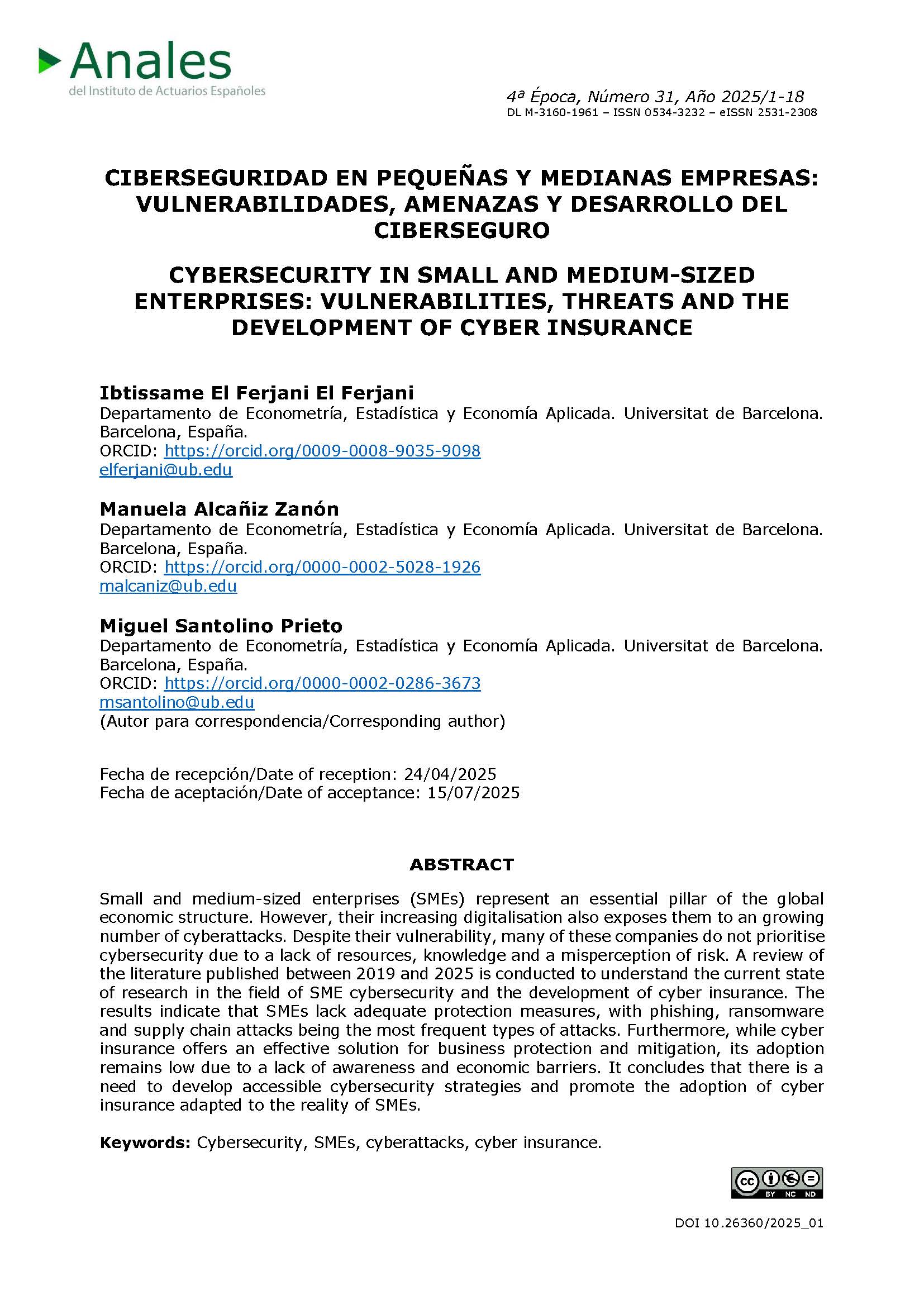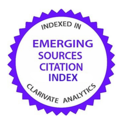Ciberseguridad en pequeñas y medianas empresas: vulnerabilidades, amenazas y desarrollo del ciberseguro
DOI:
https://doi.org/10.26360/2025_01Palabras clave:
Ciberseguridad, seguros cibernéticos, pymes, ciberataques, cibersegurosResumen
Las pequeñas y medianas empresas (pymes) representan un pilar esencial del tejido económico global, pero su creciente digitalización también las expone a un número cada vez mayor de ciberataques. A pesar de su vulnerabilidad, muchas de estas empresas no priorizan la ciberseguridad debido a la falta de recursos, conocimientos y percepción errónea del riesgo. Este estudio tiene como objetivo analizar los principales riesgos cibernéticos que enfrentan las pymes, los tipos de ciberataques más comunes y el papel del seguro cibernético como estrategia de mitigación y protección. Se lleva a cabo una revisión de la literatura publicada entre 2019 y 2025 para conocer el estado actual de investigación en el ámbito de la ciberseguridad de las pymes y el desarrollo de los seguros cibernéticos. Los resultados indican que las pymes carecen de medidas de protección adecuadas, siendo el phishing, el ransomware y los ataques a la cadena de suministro los ataques más frecuentes. Además, aunque los seguros cibernéticos ofrecen una solución efectiva para la protección empresarial, su adopción sigue siendo baja debido a la falta de conocimiento y barreras económicas. Se concluye que es necesario desarrollar estrategias accesibles de ciberseguridad y promover la adopción de seguros cibernéticos adaptados a la realidad de las pymes.
Descargas
Citas
Adriko, R., & Nurse, J. R. (2024). Cybersecurity, cyber insurance and small-to-medium-sized enterprises: A systematic review. Information & Computer Security, 32(5), 691–710. https://doi.org/10.1108/ICS-01-2024-0025
Alahmari, A., & Duncan, B. (2020). Cybersecurity risk management in small and medium-sized enterprises: A systematic review of recent evidence. 2020 International Conference on Cyber Situational Awareness, Data Analytics and Assessment (CyberSA), Dublin, Ireland, 2020, 1–5. https://doi.org/10.1109/CyberSA49311.2020.9139638
Al-Baldawi, Z. A., Kassam, A. H., & Al-Zubaidi, S. S. A. (2024). Assessment the Level of Importance of SME Lean Activities Using an Integrated Model Based on Fuzzy Logic. Management and Production Engineering Review, 15. https://doi.org/10.24425/mper.2024.149991
Aranda, A. (2024) “Los altos ejecutivos son objetivos codiciados por los hackers. Descubre cómo preparar y proteger los datos de los altos cargos en la empresa frente a los ataques cibernéticos” Capterra, https://www.capterra.es/blog/7564/ciberataques-empresas-espanolas
Arroyabe, M. F., Arranz, C. F., De Arroyabe, I. F., & de Arroyabe, J. C. F. (2024). Revealing the realities of cybercrime in small and medium enterprises: Understanding fear and taxonomic perspectives. Computers & Security, 141, 103826. https://doi.org/10.1016/j.cose.2024.103826
Beirlant, J., Goegebeur, Y., Teugels, J., & Segers, J. (2004). Statistics of extremes: Theory and applications. Wiley. https://doi.org/10.1002/0470012382
Chen, M., Chernozhukov, V., Fernández-Val, I., & Melly, B. (2016). Counterfactual analysis in R: A vignette. arXiv. https://arxiv.org/abs/1610.07894v1
Chernozhukov, V., Fernández-Val, I., & Melly, B. (2013). Inference on counterfactual distributions. Econometrica, 81(6), 2205–2268. https://doi.org/10.3982/ECTA10582
Chernozhukov, V., Fernández-Val, I., Melly, B., & Wüthrich, K. (2020). Generic inference on quantile and quantile effect functions for discrete outcomes. Journal of the American Statistical Association, 115(529), 123–137. https://doi.org/10.1080/01621459.2019.1611581
Chidukwani, A., Zander, S., & Koutsakis, P. (2022). A survey on the cyber security of small-to-medium businesses: Challenges, research focus and recommendations. IEEE Access, 10, 85701–85719. https://doi.org/10.1109/ACCESS.2022.3197899
Chidukwani, A., Zander, S., & Koutsakis, P. (2024). Cybersecurity preparedness of small-to-medium businesses: A Western Australia study with broader implications. Computers & Security, 145, 104026. https://doi.org/10.1016/j.cose.2024.104026
Dirección General de Industria y de la Pyme (DGIP) (2025). Cifras PyME: Datos diciembre 2024. Ministerio de Industria y Turismo. https://ipyme.org/Publicaciones/Cifras%20PYME/CifrasPyme-diciembre2024.pdf
El Ferjani, I., Surroca, M., Santolino, M. (2025) Análisis regional de burbujas en el número de consultas sobre ciberseguridad de las empresas. XLIX International Conference on Regional Science, Navarra, 15-17 Octubre.
E&N. (2023). Recuperarse de ciberataques cuesta 20 veces más que invertir en protección. Revista Estrategia & Negocios. https://www.revistaeyn.com/empresasymanagement/recuperarse-de-ciberataques-cuesta-20-veces-mas-que-invertir-en-proteccion-GG13371250
Gundu, T. (2019). Acknowledging and reducing the knowing and doing gap in employee cybersecurity compliance. In ICCWS 2019 14th International Conference on Cyber Warfare and Security (pp. 94–102).
Herath, B.M.T.I.T. (2024). The economic impact of cyberattacks: A comprehensive analysis. Social Science Research Network. https://ssrn.com/abstract=4885666
Instituto Nacional de Ciberseguridad de España (INCIBE) (2024). Las principales vulnerabilidades de una pyme en materia de ciberseguridad. INCIBE. https://www.incibe.es/empresas/blog/las-principales-vulnerabilidades-de-una-pyme-en-materia-de-ciberseguridad
Imízcoz, J. (2025). Una pyme podría perder 50.000 euros de media tras un ciberataque.El Mundo. https://compartiendoconocimiento.elmundo.es/una-pyme-podria-perder-50-000-euros-de-media-tras-un-ciberataque
Junior, C. R., Becker, I., & Johnson, S. (2023). Unaware, unfunded and uneducated: A systematic review of SME cybersecurity. arXiv preprint arXiv:2309.17186. https://doi.org/10.48550/arXiv.2309.17186
Koenker, R., & Bassett, G. (1978). Regression quantiles. Econometrica, 46(1), 33–50. https://doi.org/10.2307/1913643
Koenker, R. (2005). Quantile regression. Cambridge University Press. https://doi.org/10.1017/CBO9780511754098
Kostyaeva, E. V., & Chernyakov, M. K. (2020). Factors of development of insurance of small and medium-sized businesses in the conditions of digitalization. In 2nd International Scientific and Practical Conference on Digital Economy (ISCDE 2020)(pp. 417–423). Atlantis Press. https://doi.org/10.2991/aebmr.k.201205.070
Lloyd, G. (2020). The business benefits of cyber security for SMEs. Computer Fraud & Security, 2020(2), 14–17.https://doi.org/10.1016/S1361-3723(20)30019-1
Machado, J. A. F., & Santos Silva, J. M. C. (2005). Quantiles for counts. Journal of the American Statistical Association, 100(472), 1226–1237. https://doi.org/10.1198/016214505000000330
Montiel (2024) Por qué las pymes también deben priorizar la ciberseguridad en 2025.Oficinas Montiel. https://www.oficinasmontiel.com/blog/por-que-pymes-priorizar-ciberseguridad-2025/
Moriña, D., Fernández-Fontelo, A., Cabaña, A., Puig, P. (2021). New statistical model for misreported data with application to current public health challenges. Sci Rep 11, 23321 https://doi.org/10.1038/s41598-021-02620-5
Mott, G., Turner, S., Nurse, J. R., MacColl, J., Sullivan, J., Cartwright, A., & Cartwright, E. (2023). Between a rock and a hard (ening) place: Cyber insurance in the ransomware era. Computers & Security, 128. https://doi.org/10.1016/j.cose.2023.103162
Ordóñez, A. (2025). Los 'otros' costes que los ciberataques propinan a las pymes. CESCE. https://www.cesce.es/es/w/asesores-de-pymes/costes-ciberataques
Ponsard, C., Grandclaudon, J., & Bal, S. (2019). Survey and lessons learned on raising SME awareness about cybersecurity. ICISSP, 558–563. https://doi.org/10.5220/0007574305580563
PwC (2020). Informe del estado de cultura de ciberseguridad en el entorno empresarial. PricewaterhouseCoopers España, Cyber Risk Culture https://www.pwc.es/es/publicaciones/digital/informe-cultura-ciberseguridad.pdf
PwC (2024). Una de cada cinco empresas tiene previsto aumentar su presupuesto de ciberseguridad más de un 11% en 2025. PricewaterhouseCoopers España https://www.pwc.es/es/sala-prensa/notas-prensa/2024/empresas-aumento-presupuesto-ciberseguridad-2025.html
Saha, B. and Anwar, Z. (2024). A Review of Cybersecurity Challenges in Small Business: The Imperative for a Future Governance Framework. Journal of Information Security, 15, 24-39. https://doi.org/10.4236/jis.2024.151003
Salzberger, A. (2025). An empirical analysis of the behavioral influences and information sources affecting the cyber insurance decisions of German SMEs. Journal of Risk Finance.https://doi.org/10.1108/JRF-05-2024-0151
Soyer, B., Nicholas, A., & Leloudas, G. (2023). Cyber risk insurance –An effective risk management tool for SMEs in the UK? Edinburgh Law Review, 27(2), 157–184. https://doi.org/10.3366/elr.2023.0826
Tam, T., Rao, A., & Hall, J. (2021). The good, the bad and the missing: A narrative review of cyber-security implications for Australian small businesses. Computers & Security, 109, 102385. https://doi.org/10.1016/j.cose.2021.102385
Taskin, N., Özkeleş Yıldırım, A., Ercan, H. D., Wynn, M., & Metin, B. (2025). Cyber insurance adoption and digitalisation in small and medium-sized enterprises. Information, 16(1), 66. https://doi.org/10.3390/info16010066
Verma, S., Boonsanong, V., Hoang, M., Hines, K., Dickerson, J., & Shah, C. (2024). Counterfactual explanations and algorithmic recourses for machine learning: A review. ACM Computing Surveys, 56(12), Article 12. https://doi.org/10.1145/3677119
Wee, B. V., & Banister, D. (2016). How to write a literature review paper? Transport Reviews, 36(2), 278–288.https://doi.org/10.1080/01441647.2015.1065456
Zhang Wu, M., Luo, J., Fang, X., Xu, M., & Zhao, P. (2021). Modeling multivariate cyber risks: deep learning datingextreme value theory. Journal of Applied Statistics, 50(3), 610–630. https://doi.org/10.1080/02664763.2021.1936468

Publicado
Cómo citar
Número
Sección
Licencia
Derechos de autor 2025 Miguel Angel Santolino Prieto, Ibtissame El Ferjani El Ferjani, Manuela Alcañiz Zanón

Esta obra está bajo una licencia internacional Creative Commons Atribución-NoComercial-SinDerivadas 4.0.

















